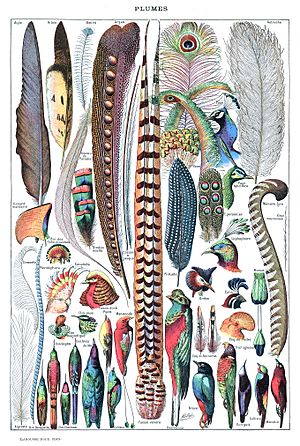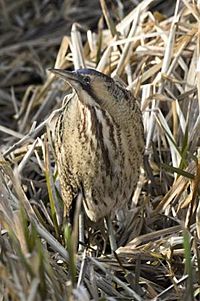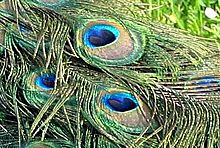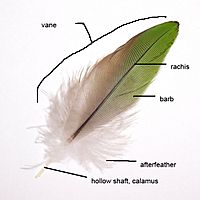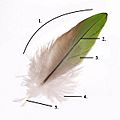Feather facts for kids
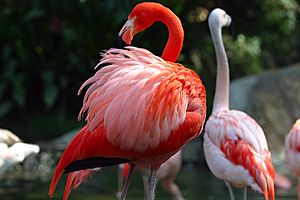
Feathers are special coverings found only on birds. They help birds stay warm and dry. Feathers also protect birds from getting hurt. For most birds, feathers are very important for flying.
Contents
What Feathers Do
Feathers keep birds warm and protect them from water and cold. Birds sometimes pull out soft feathers to make their nests cozy. These feathers help keep eggs and baby birds warm. The feathers on a bird's wings and tail are key for controlling how they fly. Some birds even have a fancy crest of feathers on their heads. Even though feathers feel light, all the feathers on a bird can weigh two or three times more than its bones! This is because many bird bones are hollow and filled with air.
The male club-winged manakin has special wing feathers. These feathers help it make sounds by rubbing them together, like a musical instrument.
Powder Down Feathers
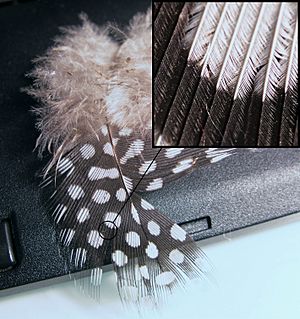
Some birds have special powder down feathers. These feathers grow all the time. Tiny pieces break off from them, making a fine powder. This powder spreads through the bird's other feathers. It helps make them waterproof and keeps them in good condition.
Powder down feathers are found in different birds, like pigeons and parrots. Herons use their beak to spread the powder. Cockatoos might use their head like a powder puff! If a bird's feathers get dirty from things like oil spills, they can lose their waterproofing. This can make the bird sink in water. It is very hard to clean birds covered in oil.
Cormorants have feathers that soak up water. This helps them become less floaty, so they can swim underwater easily.
Bristle Feathers
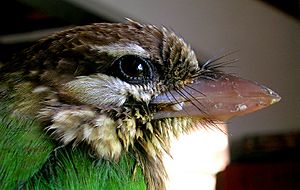
Some birds have stiff, pointy feathers called bristles. Rictal bristles are found around a bird's eyes and beak. They might work like eyelashes or whiskers on mammals. Scientists think these bristles might help birds that eat insects catch their food. However, studies have shown that some birds, like the willow flycatcher, can still catch insects just as well even if these bristles are removed.
Grebes and Feathers
Grebes are interesting birds because they eat their own feathers. They also feed feathers to their young. Scientists believe eating feathers helps them form pellets that are easy to spit out. This might help them digest their diet of fish.
Feather Colors
Feathers give birds their amazing colours. Color is very important for birds in many ways:
- Camouflage: Colors help birds hide in their natural environment. This is especially true when they are sitting still, like on a nest. For example, a bittern on its nest uses its colors to blend in perfectly.
- Display: Birds use bright or special colors to get noticed by other birds. Often, the male bird has the showy colors and does the displaying. The female bird usually has more camouflaged colors. Displaying often involves special bird songs or dances.
- To attract a mate.
- To show and protect their territory.
Types of Feathers
Vaned Feathers
The main feathers that cover the outside of a bird are called vaned feathers. These feathers have a stiff center part, called a quill. On the sides of the quill are soft, hair-like parts called barbs. This type of feather is called pennaceous because it looks like an old-fashioned pen.
Down Feathers
Young birds have small, fluffy feathers called down. These feathers keep them warm but cannot be used for flying. Down is very soft. Adult birds also have down feathers, but their vaned feathers cover the down. Down is often used to stuff blankets and pillows because it is so soft and warm. Down feathers are an example of plumaceous feathers, which means 'fluffy'. The feathers on birds that cannot fly, like the ostrich, are also plumaceous.
Moulting Feathers
Birds lose their feathers at certain times of the year. This process is called moulting. By moulting, a bird can replace its old, worn-out feathers with new, strong ones. Many birds moult once every year.
How People Use Feathers
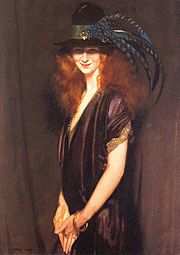
People have used feathers for many things throughout history. In the past, the stiff quills of feathers were used as pens for writing. Colorful feathers were also popular for decorating hats. Today, many pillows, cushions, mattresses, coats, and quilts are filled with soft down feathers. People from many different cultures and tribes also use feathers for decoration.
Images for kids
-
Colors from different feather pigments. Left: Red and green on the wing of a Tauraco bannermani. Right: Red and dark colors on the belly/wings of a Ramphocelus bresilius.
-
A Pomo fully feathered basket at the Jesse Peter Multicultural Museum.
-
A Mexican featherwork painting of Isidore the Laborer. This art style mixes old traditions with Christian art.
-
Archaeopteryx lithographica (Berlin specimen), an ancient bird.
See also
 In Spanish: Pluma para niños
In Spanish: Pluma para niños


